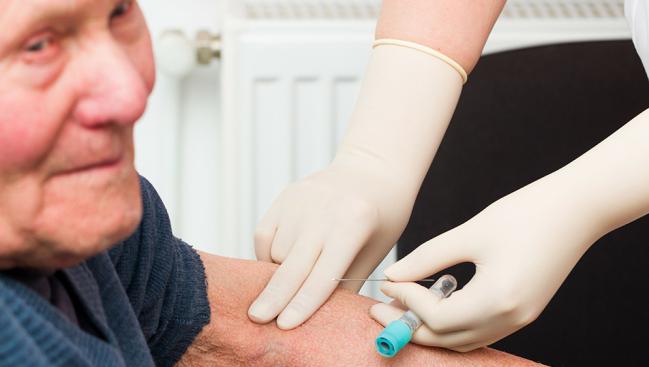Myocardial Injury After Cardiac Surgery: Time for New hs-cTnT Thresholds?
A retrospective review hints that using hs-troponin to predict events after CV surgery warrants rethinking definitions of “high.”

Levels of high-sensitivity cardiac troponin T (hs-cTnT) after cardiac surgery that are linked to an increased risk of 30-day death are substantially higher than what current consensus statements recommend as thresholds for the detection of perioperative myocardial injury (PMI), retrospective data show.
The findings are mostly in line with what the VISION cardiac surgery study found, although that one looked at high-sensitivity cardiac troponin I (hs-cTnI).
“The thresholds suggested by our study are markedly higher than previously suggested ones,” write Leo Pölzl, MD (Medical University of Innsbruck, Austria), and colleagues. “These results provide important novel insights into the association of hs-cTnT with 30-day mortality and indicate that the thresholds used in current definitions of periprocedural myocardial injury are too conservative in predicting mortality.”
Allan Jaffe, MD (Mayo Clinic, Rochester, MN), commenting for TCTMD, said that this study, in conjunction with VISION, confirms the value of identifying a high-risk group with hs-cTn assays. “What it suggests is that injury is a bad thing, and it is likely that whatever we can do to reduce it will help patients.” This study identifies a small subset at risk and in so doing, helps to pinpoint a group that might benefit from prophylactic therapies. This “opens a window of opportunity for us to investigate why that occurs and particularly whether or not this is due to a primary vascular problem. If so, can we do something about it?”
The study was published online ahead of the September 26, 2023, issue of the Journal of the American College of Cardiology.
New Thresholds Identified
For the study, the researchers retrospectively identified 8,292 patients (median age 68 years; 31% female) undergoing cardiac surgery with cardiopulmonary bypass (32.3% isolated CABG, 14.0% isolated aortic valve replacement [AVR], and 53.8% other cardiac surgery) at their institution between May 2010 and December 2020. All patients had serial perioperative hs-cTnT measurements performed using the Elecsys Troponin T high-sensitivity assay (Roche Diagnostics).
At baseline, 24% and 14% of patients had histories of MI and prior PCI, respectively. Also, 38% and 39% had heart failure symptoms classified as NYHA class II or III, respectively. The median preoperative hs-cTnT was 13.8 ng/L and N-terminal pro–B-type natriuretic peptide was 556 ng/L. Postoperatively, the median peak concentration of hs-cTnT in all patients was 981 ng/L; broken down by surgery type, these levels were 1,044 ng/L, 502 ng/L, and 1,110 ng/L, for CABG, AVR, and other cardiac surgery patients, respectively.
At 30 days, 2.5% had died, including 1.7% of patients who’d undergone isolated CABG, the same percentage of AVR patients, and 3.1% of patients who’d had other cardiac procedures. Postoperative levels of hs-cTnT were associated with higher risk of 30-day mortality overall, with an area under the curve (AUC) of 0.725; the highest predictive value was in CABG patients (AUC 0.796). The predictive power decreased over time, with an AUC of only 0.586 for 5-year mortality.
Based on their observations, researchers identified the following thresholds defining mortality-associated PMI:
- CABG: 2,385 ng/L (170 times the upper reference limit [URL] of normal in a seemingly healthy population)
- AVR: 568 ng/L (41 times the URL)
- Other cardiac surgery: 1,873 ng/L (134 times the URL)
On multivariate analysis, hs-cTnT levels above the cutoffs led to a more than 12-fold increase in risk for 30-day mortality in CABG patients (HR 12.56; 95% CI 6.81-23.16), as well as roughly fourfold increases in this risk for patients undergoing AVR (HR 4.44; 95% CI 1.61-12.25) and other cardiac surgery (HR 3.97; 95% CI 2.81-5.61).
Similar findings were observed in a sensitivity analysis looking only patients undergoing elective procedures.
Comparisons to VISION
Jaffe stressed that the value of the study is not so much in the “magic numbers” it identifies as thresholds but more so in the confirmation that “there was a continuous relationship between the amount of troponin and mortality.” With a high-risk group now identified with the highest levels of hs-cTnT after cardiac surgery, future studies can dig deeper to determine what might be done to help them, he added.
The biggest questions he would ask of this cohort relate to the contribution of ischemia, the effect of possible PCI intervention, and whether performing coronary angiography or CT angiography would help, Jaffe said. “If we can find something that is potentially remediable in these patients, we ought to go after [it],” he commented. That said, he added, “finding an optimal value to optimize the AUC might change with larger studies, and the important [message] is: the more injury there is, the worse.”
In an accompanying editorial, VISION lead author P.J. Devereaux, MD, PhD (Population Health Research Institute, Hamilton, Canada), and colleagues note that while this study reported higher threshold values for hs-cTnT associated with 30-day mortality among patients who underwent isolated CABG compared with those who underwent isolated AVR and other cardiac surgeries, the VISION study identified similar hs-cTnI values in CABG and AVR patients but higher values for those undergoing other cardiac surgery.
“These differences in results between these two studies may relate to differences between hs-cTnT and hs-cTnI,” they suggest. But they note that there were also differences in study design—the current analysis was retrospective, unblinded, and conducted at a single center, whereas VISION was blinded, prospective, and conducted at 24 hospitals in 12 countries.
Regardless, the findings here indicate that “current diagnostic criteria for perioperative myocardial infarction/injury need to be updated with these high-sensitivity cardiac troponin data,” Devereaux and colleagues argue.
They recommend using a hs-cTnT diagnostic criterion threshold of 170 times the URL during the first 72 hours after cardiac surgery for PMI and MI.
“In addition, researchers, research funders, and regulators need to require and fund high-quality research to establish diagnostic criteria informed by prognostic relevance,” the editorialists conclude. “Without such action, there will likely remain uncertainty regarding the importance or comparability of various diagnoses or the same diagnosis in different settings.”
Yael L. Maxwell is Senior Medical Journalist for TCTMD and Section Editor of TCTMD's Fellows Forum. She served as the inaugural…
Read Full BioSources
Pölzl L, Engler C, Sterzinger P, et al. Association of high-sensitivity cardiac troponin T with 30-day and 5-year mortality after cardiac surgery. J Am Coll Cardiol. 2023;82:1301-1312.
Devereaux PJ, Whitlock R, Lamy A. Perioperative myocardial injury/infarction after cardiac surgery: the diagnostic criteria need to change._ J Am Coll Cardiol._ 2023;82:1313-1315.
Disclosures
- Pölzl reports no relevant conflicts of interest.
- Jaffe reports serving as a consultant for all of the major troponin assay manufacturers.
- Devereaux reports being a member of a research group with a policy of not accepting honoraria or other payments from industry for personal financial gain; they do accept honoraria/payments from industry to support research endeavors and costs to participate in meetings; based on study questions he originated and grants he has written, he has received grants from Abbott Diagnostics, AOP, AstraZeneca, Bayer, Boehringer Ingelheim, Bristol Myers Squibb, Cloud DX, Covidien, Octapharma, Philips Healthcare, Roche Diagnostics, Roche, Siemens, Stryker, and Trimedic; has participated in advisory board meetings for GlaxoSmithKline, Bayer, Quidel Canada, and Trimedic; has participated in expert panel meetings with AstraZeneca, Boehringer Ingelheim, and Roche; and has participated in international meetings with AOP.





Comments